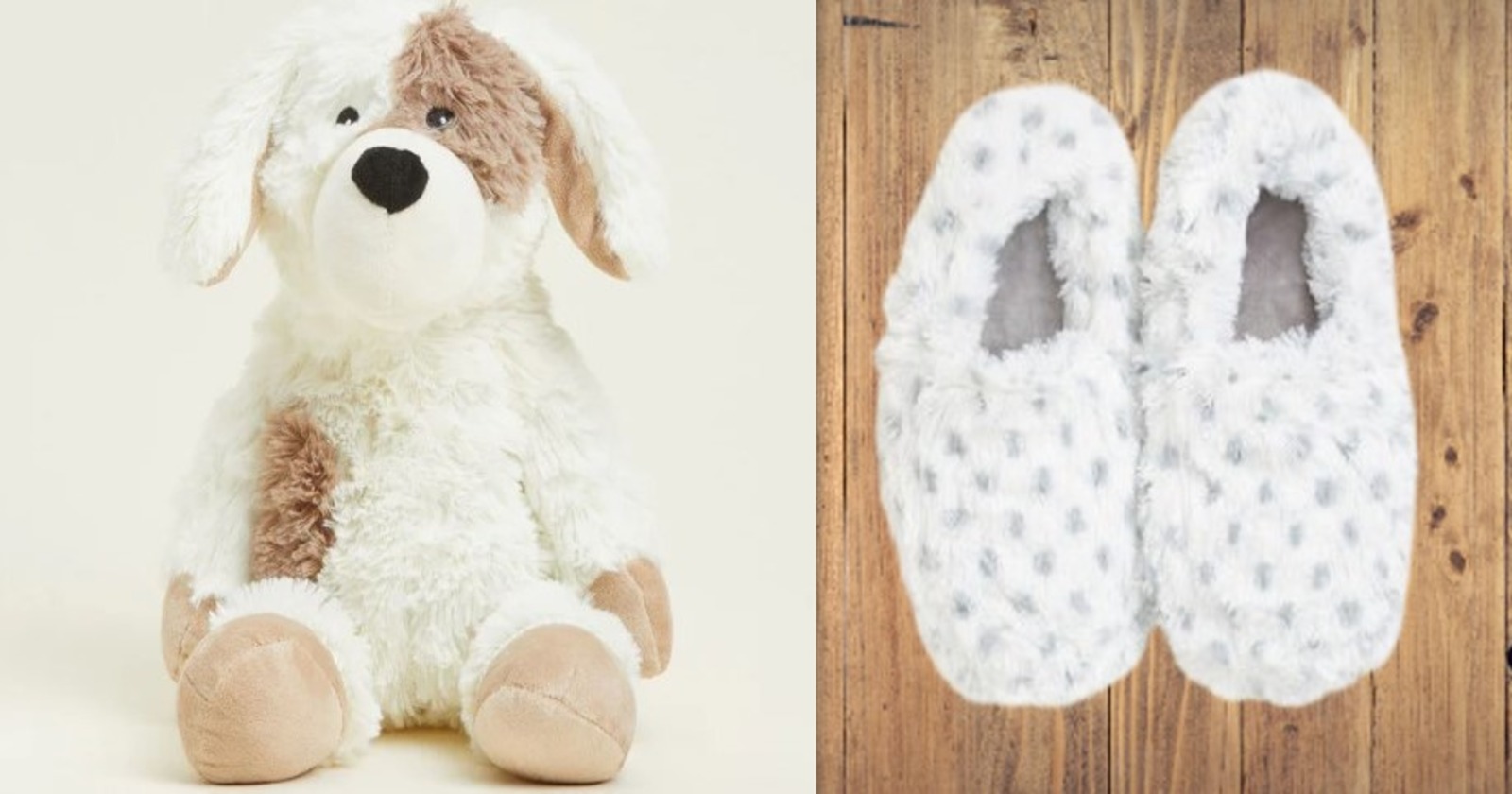A Warmie is a type of microwavable stuffed animal designed to provide warmth and comfort. These plush toys are filled with natural grains and dried French lavender, which allows them to be heated in a microwave.
Warmies can provide soothing heat and a calming lavender scent when warmed, making them ideal for relaxation, pain relief, and sensory comfort. They are often used for therapeutic purposes, particularly for individuals with sensory processing disorders, anxiety, or other conditions that benefit from heat therapy and the comforting presence of a soft, warm toy.
Here is a table with different types of Warmies and their uses:
| Type of Warmies | Uses |
|---|---|
| Plush Animals | Sensory comfort, bedtime routine, transition support |
| Slippers | Warmth and comfort for feet, anxiety and stress relief |
| Neck Wraps | Soothing neck pain, relaxation, reducing muscle tension |
| Eye Masks | Calming effects, aiding sleep, reducing headaches |
| Hand Warmers | Warming hands, stress relief, sensory input |
| Heat Packs | Pain relief, soothing tummy aches, reducing muscle cramps |
| Booties | Foot warmth, comfort for cold feet, relaxation |
| Cozy Hugs | Full body comfort, sensory support, bedtime routine |

Warmies and Sensory Processing Disorders
How Warmies Help with Sensory Regulation
Warmies are plush, microwavable stuffed animals that provide warmth and comfort. They are often used to help individuals with sensory processing disorders (SPD) by offering soothing sensory input. Here’s how they help:
- Thermal Comfort: The warmth provided by microwaving Warmies can be calming, helping to relax muscles and reduce stress.
- Aromatherapy: Many Warmies are filled with lavender, which has calming properties that can help reduce anxiety and promote sleep.
- Tactile Stimulation: The soft texture of Warmies provides gentle tactile input, which can be soothing for individuals with SPD.
- Routine and Predictability: Using Warmies can create a comforting routine, providing a sense of security and predictability.
Benefits of Weighted Warmies for Deep Pressure Stimulation
Weighted Warmies provide deep pressure stimulation, which is a form of proprioceptive input that can help with sensory regulation. The benefits include:
- Calming Effect: Deep pressure stimulation can have a calming effect on the nervous system, reducing anxiety and helping with relaxation.
- Improved Focus and Attention: The proprioceptive input from weighted Warmies can help improve focus and attention, especially in children with ADHD.
- Better Sleep: The combination of warmth, weight, and lavender can help promote better sleep by creating a soothing environment.
- Reduction in Sensory Overload: Weighted Warmies can help ground individuals who are feeling overwhelmed by sensory input, providing a sense of security and stability.

Case Studies and Testimonials
While specific case studies on Warmies might be limited, numerous testimonials from parents and therapists highlight their benefits:
- Parent Testimonials:
- “My child with autism loves his Warmie. The weight and warmth help him calm down during meltdowns, and he uses it every night to help him fall asleep.”
- “Our Warmie has become a part of our bedtime routine. The lavender scent and warmth help my daughter relax and transition to sleep more easily.”
- Therapist Testimonials:
- “I recommend Warmies to many of my clients with sensory processing issues. The deep pressure and warmth provide the sensory input they need to feel calm and focused.”
- “Weighted Warmies have been a game-changer in my practice. They are particularly useful during therapy sessions to help children with sensory modulation issues stay engaged and calm.”
- Case Study Example:
- A 7-year-old boy with SPD and ADHD started using a weighted Warmie during school and at home. His teacher noted improved attention and reduced anxiety during class, while his parents reported better sleep and fewer meltdowns at home. The combination of deep pressure and warmth provided the sensory input he needed to feel regulated and calm.
Incorporating Warmies into sensory diets and routines can be a beneficial tool for managing sensory processing disorders, providing comfort, and improving overall well-being.
Warmies Benefits for Individuals with Sensory Processing Disorders
- Sensory Stimulation:
- Warmies provide gentle heat, which can be soothing for individuals who seek warmth and comfort.
- The plush texture offers tactile stimulation, which can be calming for those who enjoy soft, cuddly objects.
- Anxiety Reduction:
- The warmth and weight of Warmies can create a calming effect, helping to reduce anxiety and stress.
- They can be used as a tool for self-soothing during times of distress or sensory overload.
- Improved Sleep:The warmth and comfort provided by Warmies can help improve sleep quality, which is often a challenge for individuals with sensory processing disorders.

Warmies Role and benefits in Autism
Warmies, which are microwavable plush toys filled with natural grains and dried lavender, offer several benefits for individuals with autism, particularly in therapeutic and everyday settings. Here’s how Warmies can be beneficial:
1. Sensory Integration:
- Tactile Stimulation: Warmies provide a soft, comforting texture that can be soothing for children with autism, who often have sensory processing issues.
- Weight and Pressure: The gentle weight of Warmies can provide a calming, grounding effect similar to a weighted blanket, which is beneficial for individuals who seek deep pressure stimulation.

2. Calming Effect:
- Warmth: When heated, Warmies provide gentle warmth that can help relax muscles and reduce stress. This warmth can be especially comforting during meltdowns or times of anxiety.
- Lavender Scent: The natural lavender scent can have a calming effect, helping to reduce anxiety and promote relaxation and sleep.
3. Emotional Regulation:
- Comfort and Security: The soft, cuddly nature of Warmies can provide emotional comfort and a sense of security, which is crucial for individuals with autism who may experience frequent anxiety or emotional distress.
- Routine and Consistency: Having a familiar and comforting object like a Warmie can be an important part of a daily routine, providing consistency and predictability.
4. Therapeutic Use:
- Occupational Therapy: Warmies can be used in occupational therapy to help improve sensory processing and integration. They can be incorporated into activities designed to calm and focus the child.
- Behavioral Therapy: In behavioral therapy, Warmies can be used as a positive reinforcement tool or a calming aid during stressful situations or transitions.
5. Sleep Aid:
- Improved Sleep Quality: The warmth and lavender scent of Warmies can help individuals with autism fall asleep faster and stay asleep longer, improving overall sleep quality.

- Bedtime Routine: Including Warmies in a bedtime routine can create a calming environment that signals it’s time to sleep, helping establish healthy sleep habits.
6. Social and Emotional Development:
- Companion: Warmies can serve as a companion, providing a sense of companionship and reducing feelings of loneliness.
- Emotional Expression: For children who have difficulty expressing emotions, Warmies can be a tool to help communicate feelings and practice empathy by taking care of their plush toy.
7. Portability:
- On-the-Go Comfort: Warmies can be easily taken on trips or outings, providing a familiar source of comfort in new or potentially stressful environments.
- Travel Stress Reduction: The calming effects of Warmies can be particularly beneficial during travel, reducing travel-related anxiety.
8. Versatility:
- Hot and Cold Therapy: Warmies can also be used cold, providing versatility for different therapeutic needs, such as soothing aches and pains or cooling down on a hot day.
Warmies are a versatile and beneficial tool for individuals with autism, providing sensory, emotional, and therapeutic benefits that can significantly enhance their quality of life.
Therapeutic Benefits of Warmies for Autism
1. Calming Effects on Children with Autism
Warmth and Comfort:
- Soothing Heat: Warmies can be heated in a microwave to provide gentle warmth, which has a calming effect on children with autism. The heat can help relax muscles and reduce tension, promoting a sense of security and comfort.
- Soft Texture: The plush and soft texture of Warmies is comforting to touch, which can help soothe children who might be experiencing anxiety or sensory overload.
Aromatherapy:
- Lavender Scent: Many Warmies are infused with dried lavender, known for its calming and relaxing properties. The gentle scent can help reduce anxiety and promote a sense of calm, aiding in emotional regulation for children with autism.
Weighted Sensation:
- Grounding Effect: The slight weight of Warmies can provide a grounding sensation, similar to the benefits of weighted blankets. This can help children feel more secure and can be particularly beneficial during moments of heightened anxiety or stress.
2. Using Warmies in Sensory Rooms
Multisensory Stimulation:
- Tactile Input: Warmies provide tactile input through their soft texture and slight weight, which can be used as part of sensory integration therapy to help children process tactile stimuli more effectively.
- Thermal Sensation: The warmth from heated Warmies can be incorporated into sensory rooms to offer thermal input, which can be both soothing and a valuable part of sensory experiences.
Versatility in Therapy:
- Focus and Engagement: Warmies can be used as a focal point during sensory activities, helping children stay engaged and focused. This can be particularly useful in structured sensory play or relaxation sessions.
- Comfort Object: Having a Warmie in a sensory room can serve as a comfort object, helping children feel safe and secure in the environment, making them more open to participating in sensory activities.
3. Warmies as a Part of Bedtime Routines

Promoting Relaxation:
- Pre-Bedtime Calm: Introducing Warmies as part of the bedtime routine can help signal to children that it’s time to wind down. The warmth and lavender scent can create a relaxing environment conducive to sleep.
- Routine and Predictability: Incorporating Warmies into a consistent bedtime routine can provide a sense of predictability and security, which is particularly beneficial for children with autism who thrive on routine.
Improving Sleep Quality:
- Stress Reduction: The calming effects of Warmies can help reduce bedtime anxiety and stress, leading to improved sleep onset and quality.
- Comforting Presence: Having a Warmie to cuddle can provide comfort throughout the night, helping children stay asleep and feel secure if they wake up during the night.
Warmies can be a valuable therapeutic tool for children with autism, offering various benefits through their warmth, texture, and scent. Whether used in sensory rooms, as part of calming routines, or integrated into bedtime practices, Warmies can help promote relaxation, reduce anxiety, and provide a comforting presence for children with autism.
Warmie Use in Therapeutic Settings
- Occupational Therapy:
- Warmies can be integrated into sensory integration therapy to help regulate sensory input and provide comfort.
- They can be used as part of a sensory diet, where specific activities and tools are used to help individuals manage their sensory needs.
- Autism Therapy:
- For individuals with autism, Warmies can be used to help with transitions and to provide a sense of security.
- They can be used as a reward or motivator during therapy sessions.
- Emotional Regulation:
- Therapists can use Warmies to help individuals learn self-regulation techniques, such as holding a Warmie to calm down.
- They can be part of a sensory toolbox, providing a reliable and comforting option for managing emotional responses.
- Pain Management:
- The heat from Warmies can help alleviate minor aches and pains, providing additional comfort for individuals with physical discomforts.
Incorporating Warmies into Occupational Therapy Sessions

Warmies are therapeutic microwavable plush toys filled with grains and dried lavender, which provide warmth and soothing scents. They can be effectively incorporated into occupational therapy sessions to support various therapeutic goals:
- Sensory Integration: Warmies can be used to provide deep pressure and proprioceptive input, which can help individuals with sensory processing disorders. The warmth and weight of the Warmies can have a calming effect, reducing anxiety and improving focus.
- Motor Skills Development: Incorporating Warmies into activities can help improve fine and gross motor skills. For example, therapists can create games that require the child to pick up and carry the Warmie, helping to build muscle strength and coordination.
- Emotional Regulation: The comforting warmth and soothing lavender scent of Warmies can help clients self-regulate emotions. They can be used as a calming tool during sessions to help clients manage stress and anxiety.
- Routine Building: Including Warmies in a client’s daily routine can help establish consistency and predictability, which is beneficial for individuals with autism or anxiety disorders.
Guidelines for Using Warmies Effectively in Therapy
- Assess Individual Needs: Understand the sensory preferences and needs of each client. Some may respond well to warmth and lavender scent, while others may have sensitivities.
- Introduce Gradually: Introduce the Warmie gradually, allowing the client to explore and become comfortable with it at their own pace.
- Supervised Use: Always supervise the use of Warmies, especially with younger clients or those with developmental disabilities, to ensure safety and proper use.
- Incorporate into Routines: Use Warmies consistently in routines to provide a sense of predictability and security. For example, use a Warmie during the beginning or end of each session as a ritual.
- Hygiene and Maintenance: Ensure Warmies are kept clean and hygienic. Follow the manufacturer’s instructions for cleaning and maintenance to prevent the spread of germs.
- Monitor for Effectiveness: Regularly assess and monitor the effectiveness of Warmies in therapy. Adjust the use based on the client’s responses and therapeutic progress.
Warmies can be a valuable tool in occupational therapy, providing sensory comfort and support for emotional regulation. With thoughtful integration and careful monitoring, Warmies can enhance the therapeutic experience and contribute to positive outcomes for clients of all ages.
Use and Safety of Warmies
1. How to Safely Use Warmies with Children and Adults
- Supervision: Always supervise young children and individuals with special needs when using Warmies.
- Inspection: Regularly check Warmies for any signs of wear, damage, or leaks. Discontinue use if any damage is found.
- Heating: Follow the manufacturer’s instructions for heating. Generally, Warmies are microwaved for about 90 seconds (maximum) on a 1000W microwave. Adjust time accordingly for different wattages.
- Cooling: For a cooling effect, place Warmies in a plastic bag and store them in the freezer for 3-4 hours.
- Allergies: Ensure that the recipient does not have allergies to any materials or scents used in Warmies (e.g., lavender filling).
2. Temperature Guidelines and Precautions

- Heating Guidelines:
- Always start with the lowest recommended heating time and increase in small increments if necessary.
- Ensure the Warmies are evenly distributed in the microwave to avoid hot spots.
- Check the temperature before use by placing Warmies against the inner wrist or elbow, similar to how you would check a baby’s bottle.
- Precautions:
- Do not overheat, as this can damage the Warmies or cause burns.
- Never leave Warmies unattended in the microwave.
- Allow Warmies to cool down completely before reheating.
3. Cleaning and Maintenance of Warmies

- Surface Cleaning: Use a damp cloth to wipe the surface of the Warmies. Avoid soaking or submerging them in water as this can damage the filling.
- Spot Cleaning: For tougher stains, use mild soap with a damp cloth and gently clean the affected area.
- Drying: After cleaning, let the Warmies air dry completely before using them again. Do not place them in a dryer or apply direct heat for drying.
- Scent Maintenance: If the lavender scent fades over time, you can add a few drops of lavender essential oil to the Warmies, taking care not to oversaturate.
Additional Tips
- Storage: Store Warmies in a cool, dry place. When not in use, keep them in a plastic bag to maintain freshness and protect from dust.
- Usage Limitations: Avoid using Warmies on broken skin, open wounds, or if you have conditions that affect heat sensitivity, such as diabetic neuropathy.
- Consultation: If in doubt about using Warmies with certain health conditions, consult a healthcare professional.
By following these guidelines, Warmies can be a safe, comforting, and therapeutic tool for both children and adults.
How Parents Can Use Warmies to Support Their Child’s Needs
1. Sensory Comfort: Warmies can provide warmth and gentle weight, which can be soothing for children with sensory processing disorders. The lavender scent can also have a calming effect.
2. Anxiety and Stress Relief: The soothing warmth and soft texture of Warmies can help reduce anxiety and provide comfort during stressful situations, such as medical appointments or travel.
3. Bedtime Routine: Incorporating Warmies into a bedtime routine can create a sense of security and help children relax and fall asleep more easily.
4. Pain Relief: Warmies can be used to soothe minor aches and pains, such as tummy aches or growing pains, providing a natural and comforting method of relief.
5. Transition Support: Warmies can be a helpful tool during transitions, such as moving to a new home, starting school, or changing daily routines, by offering a consistent source of comfort.
Tips for Introducing Warmies to Children with Special Needs
1. Gradual Introduction: Start by introducing Warmies during calm and positive moments. Allow the child to explore the texture and scent without any pressure.
2. Create a Routine: Use Warmies at consistent times, such as during bedtime or before potentially stressful activities, to build a positive association.
3. Personalization: Let the child choose their favorite Warmies animal or color to create a sense of ownership and attachment.
4. Use as a Tool, Not a Cure: Emphasize that Warmies are a helpful tool for comfort and support but not a cure for underlying conditions. Pair with other therapeutic interventions as needed.
5. Observe and Adjust: Pay attention to the child’s reactions and adjust usage based on their comfort level. Some children may prefer Warmies at room temperature rather than heated.
Our autistic Son prefer his warmie cold.
Creating a Sensory-Friendly Environment at Home with Warmies
- Choose the Right Warmie:
- Select Warmies that are soft, have a pleasant scent (e.g., lavender), and are appropriately sized for the individual’s comfort.
- Consider various Warmies like stuffed animals, slippers, or wraps to provide different types of sensory input.
- Integrate Warmies into Daily Routines:
- Use Warmies during bedtime to promote relaxation and better sleep.
- Incorporate Warmies into calming activities, such as reading time or after a stressful day.
- Create Sensory Corners:
- Designate a quiet, cozy corner with a collection of Warmies, soft pillows, and blankets.
- Include other sensory items like weighted blankets, fidget toys, and calming lights.

4. Use Warmies for Comfort:
- Warmies can be used to provide warmth and comfort during cold weather or when the individual feels anxious or stressed.
- Encourage their use during moments of sensory overload or as a preventative measure.
5. Teach Self-Regulation:
- Help individuals recognize when they need sensory input and encourage them to use Warmies as a self-regulation tool.
Role of Warmies in Sensory-Friendly Public Spaces
- Libraries and Reading Areas:
- Provide Warmies in children’s reading corners to create a comforting environment.
- Use Warmies during storytime sessions to help children stay calm and engaged.
- Hospitals and Clinics:
- Offer Warmies in waiting rooms to help reduce anxiety and stress for patients, especially children.
- Incorporate Warmies into therapy sessions for added comfort and relaxation.
- Schools and Educational Settings:
- Include Warmies in sensory rooms or calming corners for students needing a break from sensory overload.
- Use Warmies as part of social-emotional learning programs to teach self-soothing techniques.
- Community Centers and Play Areas:
- Provide Warmies in sensory play areas to support children with sensory processing needs.
- Use Warmies during community events focused on mental health and well-being.
Community Programs Incorporating Warmies
- Sensory Storytime Programs:
- Partner with local libraries to create sensory-friendly storytime sessions with Warmies for children with autism or sensory processing disorders.
- Therapeutic Workshops:
- Collaborate with occupational therapists to offer workshops teaching parents and caregivers how to use Warmies for sensory regulation.
- Support Groups:
- Incorporate Warmies into support group meetings for individuals with sensory processing issues and their families.
- Provide Warmies as part of care packages for new members.
- Special Needs Recreational Programs:
- Integrate Warmies into recreational programs designed for children with special needs to enhance their sensory experiences.
- Use Warmies during yoga or meditation sessions to promote relaxation and mindfulness.
By incorporating Warmies into various environments and programs, you can create more inclusive and supportive spaces for individuals with sensory processing needs.
Resources
https://warmies.com/blogs/blog/best-heating-pad-for-pain-relief
https://abavistwinterchristmas.com/reindeer-warmies-remarkable-uses-health-benefits/
Most of my experiences are from my personal use of warmies and my Autistic kids.









